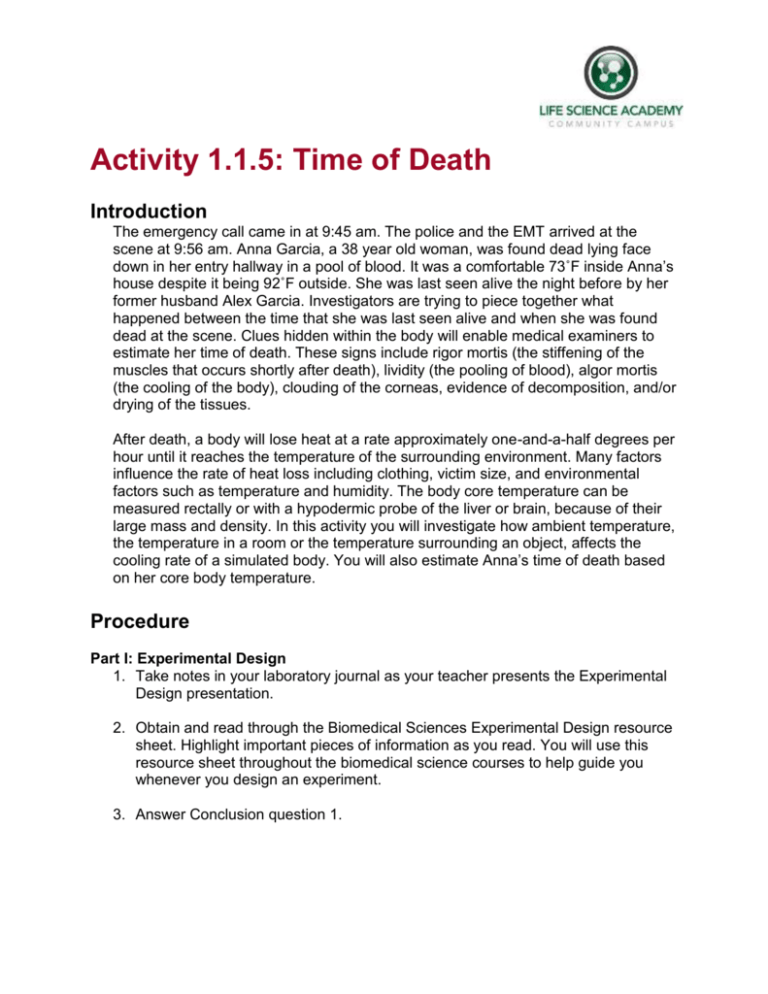Activity 1.1.5: Time of Death Introduction
advertisement

Activity 1.1.5: Time of Death Introduction The emergency call came in at 9:45 am. The police and the EMT arrived at the scene at 9:56 am. Anna Garcia, a 38 year old woman, was found dead lying face down in her entry hallway in a pool of blood. It was a comfortable 73˚F inside Anna’s house despite it being 92˚F outside. She was last seen alive the night before by her former husband Alex Garcia. Investigators are trying to piece together what happened between the time that she was last seen alive and when she was found dead at the scene. Clues hidden within the body will enable medical examiners to estimate her time of death. These signs include rigor mortis (the stiffening of the muscles that occurs shortly after death), lividity (the pooling of blood), algor mortis (the cooling of the body), clouding of the corneas, evidence of decomposition, and/or drying of the tissues. After death, a body will lose heat at a rate approximately one-and-a-half degrees per hour until it reaches the temperature of the surrounding environment. Many factors influence the rate of heat loss including clothing, victim size, and environmental factors such as temperature and humidity. The body core temperature can be measured rectally or with a hypodermic probe of the liver or brain, because of their large mass and density. In this activity you will investigate how ambient temperature, the temperature in a room or the temperature surrounding an object, affects the cooling rate of a simulated body. You will also estimate Anna’s time of death based on her core body temperature. Procedure Part I: Experimental Design 1. Take notes in your laboratory journal as your teacher presents the Experimental Design presentation. 2. Obtain and read through the Biomedical Sciences Experimental Design resource sheet. Highlight important pieces of information as you read. You will use this resource sheet throughout the biomedical science courses to help guide you whenever you design an experiment. 3. Answer Conclusion question 1. Part II: How Does Temperature Affect Body Cooling? 4. Obtain a Time of Death Experimental Design Resource Sheet. 5. Please note: The following resources have been made available to you: Computer with Logger Pro software Logger Pro mini Vernier Temperature Probe Goggles Gloves Laboratory apron Ring stand with clamp 3 Test tubes Sodium polyacrylate Weigh boats Electronic balance Thermometer Water Graduated cylinder Ice Hotplates Various PPE Room temperature water Oven mitt Graduated cylinders Beakers and flasks of various size 6. Please note: A waterclock (a common stand-in for a human body) can be constructed by placing 1 gram of sodium polyacrylate into a test tube along with 20 mL of 37˚ water. 7. Your research question is “How Does Temperature Affect Body Cooling?” Brainstorm with your partner or group how you could use the available materials to conduct an experiment, using Logger Pro to record the temperature, that might answer this research question. 8. Complete steps 1-3 in your lab notebook according to the Experimental Design Resource Sheet. Please note: Logger Pro will be set up to record data for 20 minutes for each experiment. 9. Get your instructor’s OK before proceeding. (Hint: you will use the Vernier Temperature Probe in your waterclock.) 10. Refer to the Logger Pro® resource sheet as you are working with Logger Pro software and Vernier probes for troubleshooting. Set up your logger Pro equipment for data collection in the following way: Start Logger Pro® software on your computer. Click on File Open and open the Forensics with Vernier folder. Open the program titled 14 Hot Air, Cold Body. Connect the LabQuest Mini to the computer using the USB cable. 11. Complete step 4. Carry out your experiment. Take detailed notes throughout. Follow the procedure below regarding Logger Pro®. Wait for the temperature sensor to reach the temperature of the waterlock. Click to begin data collection. Note that the experiment is set to collect data for 20 minutes. When data collection is complete (data has been collected for 20 minutes), click the Statistics button, , to display a Statistics box. Record the minimum temperature recorded and the maximum temperature recorded. Record the temperature change (displayed in the Statistics box as Δy.). Save the data to your USB. You can copy the graph by placing the mouse cursor over the graph, left clicking, and then pressing both the Control and the C keys simultaneously. Paste the graph into a Word document and save it. To paste the graph, press both the Control and the V keys simultaneously. Repeat this step in order to copy and paste the Data Table into a word document. 12. Print both, cut them out and paste them into your lab notebook. 13. Complete step 5. 14. Work with your classmates to fill in a class data table. Discuss the results. Note any similarities and differences. 15. Answer Conclusion question 4. Part III: Anna’s Time of Death The Glaister equation is one formula used to approximate the postmortem interval, or time since death. Note: This equation uses degrees Fahrenheit. Glaister Equation: 98.4 – measured rectal temperature = approximate hours since death 1.5 17. Use the Glaister equation to estimate Anna’s time of death. Show your work in your lab notebook. 18. Answer Conclusion question 5. Conclusion Questions 1. Why is it important to include a control group whenever possible in an experiment? 2. How were all outside variables that could affect the outcome of the experiment controlled? 3. How could this experiment be improved? 4. Algor mortis, or postmortem cooling of the body, varies with ambient temperatures. Based on your results, how does ambient temperature affect the rate of cooling of a body after death? Explain your answer. 5. The Glaister equation is just one formula used to approximate the postmortem interval. If Anna had died outside instead of inside her air conditioned house, would the Glaister equation be an appropriate model to use to determine her time of death? (Remember that they were in the middle of a heat wave and it was 92˚F outside.) Why or why not?
